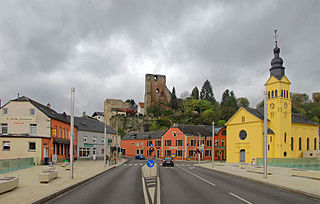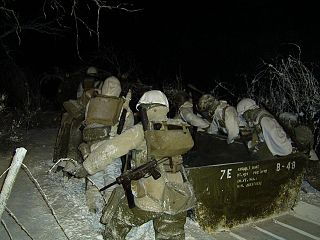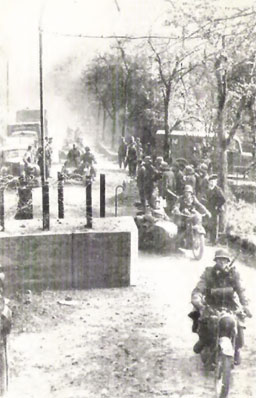
Luxembourg, officially the Grand Duchy of Luxembourg, is a small landlocked country in Western Europe. It borders Belgium to the west and north, Germany to the east, and France to the south. Luxembourg is the only surviving grand duchy in the world. Its capital and most populous city, Luxembourg, is one of the four institutional seats of the European Union and the seat of several EU institutions, notably the Court of Justice of the European Union, the highest judicial authority. Luxembourg's culture, people, and languages are highly intertwined with its French and German neighbors; while Luxembourgish is the only national language of the Luxembourgish people and of the Grand Duchy of Luxembourg, French is the only language for legislation, and all three – Luxembourgish, French and German – are used for administrative matters in the country.

The history of Luxembourg consists of the history of the country of Luxembourg and its geographical area.
The German occupation of Luxembourg in World War II began in May 1940 after the Grand Duchy of Luxembourg was invaded by Nazi Germany. Although Luxembourg was officially neutral, it was situated at a strategic point at the end of the French Maginot Line. On 10 May 1940, the German Wehrmacht invaded Luxembourg, Belgium and the Netherlands. Luxembourg was initially placed under a military administration, but later became a civilly administrated territory and finally was annexed directly into Germany. The Germans believed Luxembourg to be a Germanic state, and attempted to suppress what they perceived as alien French language and cultural influences. Although some Luxembourgers joined the resistance or collaborated with the Germans, both constituted a minority of the population. As German nationals, from 1942, many Luxembourgers were conscripted into the German military. Nearly 3,500 Luxembourgish Jews were murdered during the Holocaust. The liberation of the country by the Allies began in September 1944, but due to the Ardennes Offensive it was not completed until early 1945.

Wasserbillig is a town in the commune of Mertert, in eastern Luxembourg. As of 2005, Wasserbillig has 2,186 inhabitants, which makes it the largest town in Mertert. Wasserbillig is the administrative seat of the commune of Mertert.

The Our is a river in Belgium, Luxembourg and Germany. It is a left-hand tributary of the river Sauer/Sûre. Its total length is 78 kilometres (48 mi).

Diekirch is a commune with town status in north-eastern Luxembourg, capital city of the canton Diekirch and, until its abolition in 2015, the district of Diekirch. The town is situated on the banks of the Sauer river.

Ettelbruck is a commune with town status in central Luxembourg, with a population of 9,688 inhabitants.

Vianden is a commune with town status in the Éislek, north-eastern Luxembourg, with a population of 2,203 as of 2023. It is part of the of the canton of the same name. Vianden lies on the Our river, near the border between Luxembourg and Germany.

Wiltz is a commune with town status in north-western Luxembourg, capital of the canton Wiltz. Wiltz is situated on the banks of the river Wiltz. It was also a battleground in the Battle of the Bulge, near the end of World War II. A local airfield was used by both sides of the conflict, depending on the location of the Front.

Hesperange is a commune and town in southern Luxembourg. It is located south-east of Luxembourg City.
The Éislek is a region covering the northern part of both the Grand Duchy of Luxembourg and Eifelkreis Bitburg-Prüm, within the greater Ardennes area that also covers parts of Belgium and France. The Éislek covers 32% of the territory of Luxembourg; to the south of the Éislek lies the Gutland, which covers the remaining 68% of the Grand Duchy as well as the southern part of the Eifelkreis Bitburg-Prüm.

The Duchy of Luxemburg was a state of the Holy Roman Empire, the ancestral homeland of the noble House of Luxembourg. The House of Luxembourg, now Duke of Limburg, became one of the most important political forces in the 14th century, competing against the House of Habsburg for supremacy in Central Europe. They would be the heirs to the Přemyslid dynasty in the Kingdom of Bohemia, succeeding the Kingdom of Hungary and contributing four Holy Roman Emperors until their own line of male heirs came to an end and the House of Habsburg got the pieces that the two Houses had originally agreed upon in the Treaty of Brünn in 1364.

From August 1914 until the end of World War I on 11 November 1918, the Grand Duchy of Luxembourg was under full occupation by the German Empire. The German government justified the occupation by citing the need to support their armies in neighbouring France, although many Luxembourgers, contemporary and present, have interpreted German actions otherwise.

The XII Corps fought from northern France to Austria in World War II. Constituted in the Organized Reserves in 1933, it was activated on 29 August 1942 at Columbia, South Carolina. XII Corps became operational in France as part of Lieutenant General George S. Patton's Third Army on 1 August 1944. Initially commanded by Major General Gilbert R. Cook, bad health forced MG Cook to relinquish command to Major General Manton S. Eddy within three weeks. MG Eddy commanded the corps until late April 1945, when his own health problems forced him to turn over command to MG Stafford LeRoy Irwin.

The National Museum of Military History, abbreviated to MNMH, is a national museum in Diekirch, in north-eastern Luxembourg, that includes amongst its exhibits military vehicles and weaponry, a photographic archive, and lifesize dioramas displaying military servicemen and actions.

The Codex Mariendalenis is a manuscript on vellum containing the epic poem Yolanda vu Veianen or Yolanda of Vianden. It is believed to be the work of Brother Hermann von Veldenz who probably wrote the story of Yolanda's life in 1290 after her death in 1283. The work consists of 5,963 lines of rhyming couplets in Moselle Franconian which bears close similarities to today's Luxembourgish. It is therefore of particular interest to those tracing the history of the Luxembourgish language.

The German invasion of Luxembourg was part of Case Yellow, the German invasion of the Low Countries—Belgium, Luxembourg and the Netherlands—and France during World War II. The battle began on 10 May 1940 and lasted just one day. Facing only light resistance, German troops quickly occupied Luxembourg. The Luxembourgish government, and Grand Duchess Charlotte, managed to escape the country and a government-in-exile was created in London.

The involvement of the Grand Duchy of Luxembourg in World War II began with its invasion by German forces on 10 May 1940 and lasted beyond its liberation by Allied forces in late 1944 and early 1945.
When Luxembourg was invaded and annexed by Nazi Germany in 1940, a national consciousness started to come about. From 1941 onwards, the first resistance groups, such as the Letzeburger Ro'de Lé'w or the PI-Men, were founded. Operating underground, they secretly worked against the German occupation, helping to bring political refugees and those trying to avoid being conscripted into the German forces across the border, and put out patriotic leaflets encouraging the population of Luxembourg to pull through.

The Civil Administration Area of Luxembourg was a German civil administration in German-occupied Luxembourg that existed from 29 July 1940 to 30 August 1942, when Luxembourg was annexed into Gau Moselland.

















